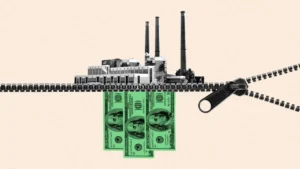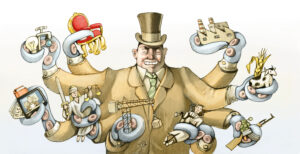The Influence Machine
The U.S. Chamber of Commerce, far from being a "small town organization that helps keep Main Street clean," is a hard-right ideological force, arguably the "single most influential organization in American politics" outside of the two major parties. Spiegel & Grau
Spiegel & Grau
Spiegel & Grau
|
To see long excerpts from “The Influence Machine” at Google Books, click here. |
“The Influence Machine: The U.S. Chamber of Commerce and the Corporate Capture of American Life” A book by Alyssa Katz
Most of us have been there: behind the wheel late at night, windows down and music blasting, our heads dipping and vision blurring, as we try to squeeze out a few more miles on the road before succumbing to exhaustion. Driving while tired is a stupid thing to do. It’s also deadly, with fatigue responsible for up to 6,000 crash fatalities a year. Yet truck drivers, due to their long work schedules, are tired pretty much all the time, as federal regulations permit them to work 16 hours in every 24-hour period. One study, published in The New England Journal of Medicine, found that truckers received an average of only five hours of sleep a night.
There was once an effort to change that. In 2000, responding to the rising number of fatalities caused by truck crashes, the Department of Transportation proposed to limit truckers to 12 hours of work in every 24-hour cycle. The Clinton administration estimated that the proposed rule — which also mandated breaks after 10 hours of continuous driving — would prevent 2,600 crashes and save 115 lives each year. As far as regulatory changes go, this one seemed uncontroversial.
Enter the U.S. Chamber of Commerce. Directed by Tom Donohue, who had formerly led the American Trucking Association, the Chamber claimed that the changes would lead to more pollution, more traffic and a rise in the cost of food. They would also, somehow, make highways more dangerous. “Our members, as well as the entire American business community, are unwilling to accept the deaths, injuries and damage which the proposed regulation will cause,” Donohue said. The regulations were never implemented, with the Chamber even able to insert language into the federal budget that blocked any future funding to research other potential rules to protect drivers.
“The trucking rules are just one obscure chunk of the millions of lines of code that run the federal government,” writes Alyssa Katz in “The Influence Machine: The U.S. Chamber of Commerce and the Corporate Capture of American Life,” her groundbreaking exposé of the Chamber of Commerce. Yet these miles of code, published in small font in the Federal Register — and read by virtually no one in the public — are often matters of life and death. Katz opens her book with the story of Susan Slattery, who was killed in 2010 when a big-rig slammed into her Ford Focus from behind. The trucker, who was so tired that he couldn’t remember how long he had been driving, had fallen asleep. Also in the car were Slattery’s two sons. Both survived, but the youngest, Matthew, now uses a wheelchair and has difficulty speaking. “Had the rule been ten hours, my wife would very likely have been alive and with us today,” Ed Slattery tells Katz. He recently retired to provide around-the-clock care for Matthew.
Katz is a policy wonk — her previous book, “Our Lot,” was about the subprime housing debacle — and one of her strengths is the ability to cut through opaque regulatory debates to clearly describe the stakes. As a student of such fights she has identified the Chamber of Commerce as the “single most influential organization in American politics” outside of either major party, a claim that may raise some eyebrows in light of more recent players, like the Koch brothers, who have muscled onto the scene and thrown around a great deal of money. The key difference, as Katz sees it, is the Chamber’s diversity of tactics and staying power. While most of the newer groups fundraise and mobilize to elect candidates, she writes, the Chamber gets into “the sweaty work of crafting bill language,” combats even the most reasonable regulatory changes and wages court battles while pushing policy. Oh, and it spent more than $1 billion in lobbying between 1998 and 2012, representing, Katz writes, “the vanguard of a business movement to redirect our national priorities through political warfare.”
The U.S. Chamber of Commerce is a curious creature. In many people’s minds, as Katz points out, it is a “small town organization that helps keep Main Street clean,” a sort of do-gooder association of striving small businesses. But its national organization is a hard-right ideological force, shilling for whichever companies foot the bill. Katz describes these fights in detail, including the Chamber’s lobbying on behalf of noxious industries such as tobacco and insurance, with the Chamber emerging as a pit bull that refuses to ever back down. (Several years ago, in an effort to stop climate change legislation, the Chamber even celebrated global warming, claiming that crops would grow faster and lives would be saved as people no longer froze to death so frequently.)
This dichotomy — local vs. national — doesn’t always hold. Many local chambers are at the forefront in the pushback against increases in the minimum wage, and in states like California, they have played a regressive role for decades, dating back to efforts to stifle farmworker organizing during the 1930s. But Katz shows that the U.S. Chamber, by moving ever further to the right, has sparked a grass-roots rebellion in its ranks, with many disaffiliating from the national organization. Last year, just 213 out of 7,000 chambers were accredited by the U.S. Chamber, and its recalcitrant position on issues like climate change has led many high-profile members, such as Apple, to resign.There was a time, not so long ago, when the U.S. Chamber was an insignificant player in politics. Founded in 1912, for most of its life the organization adhered to a strict rule: It could involve itself only with issues that affected businesses generally. By the mid-1970s, this policy forced it to watch from the sidelines as Ralph Nader and the dogged reformers he inspired helped usher in sweeping new regulations to curtail the power of corporations in industry after industry. Frustrated by the success of the consumer movement, the Chamber shifted tactics in 1976, launching an Astroturf organization — the term for a pseudo grass-roots group — called Citizen’s Choice, whose board members included “citizens” like PepsiCo and the National Association of Realtors. The group rallied against public financing of elections and for lower taxes. In six years, the Chamber’s newly energized membership nearly quadrupled, to 234,000 companies.
But growth presented another problem: With so many voices to consult in order to define an agenda, the Chamber of Commerce stalled out. “If we haven’t got a strong consensus, we just don’t move,” said one staffer. The too-much-democracy problem was solved by Donohue, who took over the Chamber in 1997 and who, more than anyone else, is responsible for its present form as a take-no-prisoners brawler. Gone today is any notion that the U.S. Chamber is anything but a surrogate for its most powerful clients, much as the American Farm Bureau, which claims to be a voice for grass-roots farmers, actually does the bidding of agricultural giants like Monsanto. When health insurance companies sought to influence the debate over what became the Affordable Care Act, it did so by donating $86.2 million to the Chamber. A key advantage of working through the Chamber is that, as a trade group, it doesn’t have to list its funders. (The insurance donation came to light only because of its sheer size, and some sleuthing by Bloomberg News.) Corporations can use the Chamber to “launder their antisocial advocacy,” Katz writes, while enjoying “near absolute brand protection,” free to wage battles without being identified as a combatant.
As a guide to what ails the U.S. political system — told through the rise of the Chamber — “The Influence Machine” performs an important service. As a read, though, the book hits a number of flat spots, and few voices pop to life. The Chamber, after receiving questions via email from Katz, refused to participate in the book or allow staffers to be interviewed, and the book suffers from this distance. And although Katz covers broad ground, the many policy fights tend to blend together.
Like many books that impressively document a problem, the solutions posited in the final pages of “The Influence Machine” are weak and dispiriting. Katz imagines a group serving as a counterpart to the Chamber for the Democrats, made up of workers, consumers and corporations. Perhaps Google will come on board and help lead the fight. Or independent businesses will unite using a platform like Kickstarter to “disrupt” the Chamber’s “deep-pocketed lock on power.” What all of these solutions have is a faith that disgruntled corporations will play a leading role in countering the power of the Chamber.
But as Katz persuasively documents, the Chamber is a symptom of a bigger problem, as its history illustrates “how American democracy fell into the hands of big business.” These big businesses — and small ones too — have a logic they must follow. They will not champion regulations that threaten their bottom line or their political power, no matter how “forward thinking” their slogans may be. Apple may leave the Chamber, but its products are still produced in Chinese sweatshops. If we expect “good” corporations to help lead us out of our age of inequality, then the “corporate capture of American life,” as Katz puts it in her subtitle, is even greater than she realizes.
Your support matters…Independent journalism is under threat and overshadowed by heavily funded mainstream media.
You can help level the playing field. Become a member.
Your tax-deductible contribution keeps us digging beneath the headlines to give you thought-provoking, investigative reporting and analysis that unearths what's really happening- without compromise.
Give today to support our courageous, independent journalists.






You need to be a supporter to comment.
There are currently no responses to this article.
Be the first to respond.